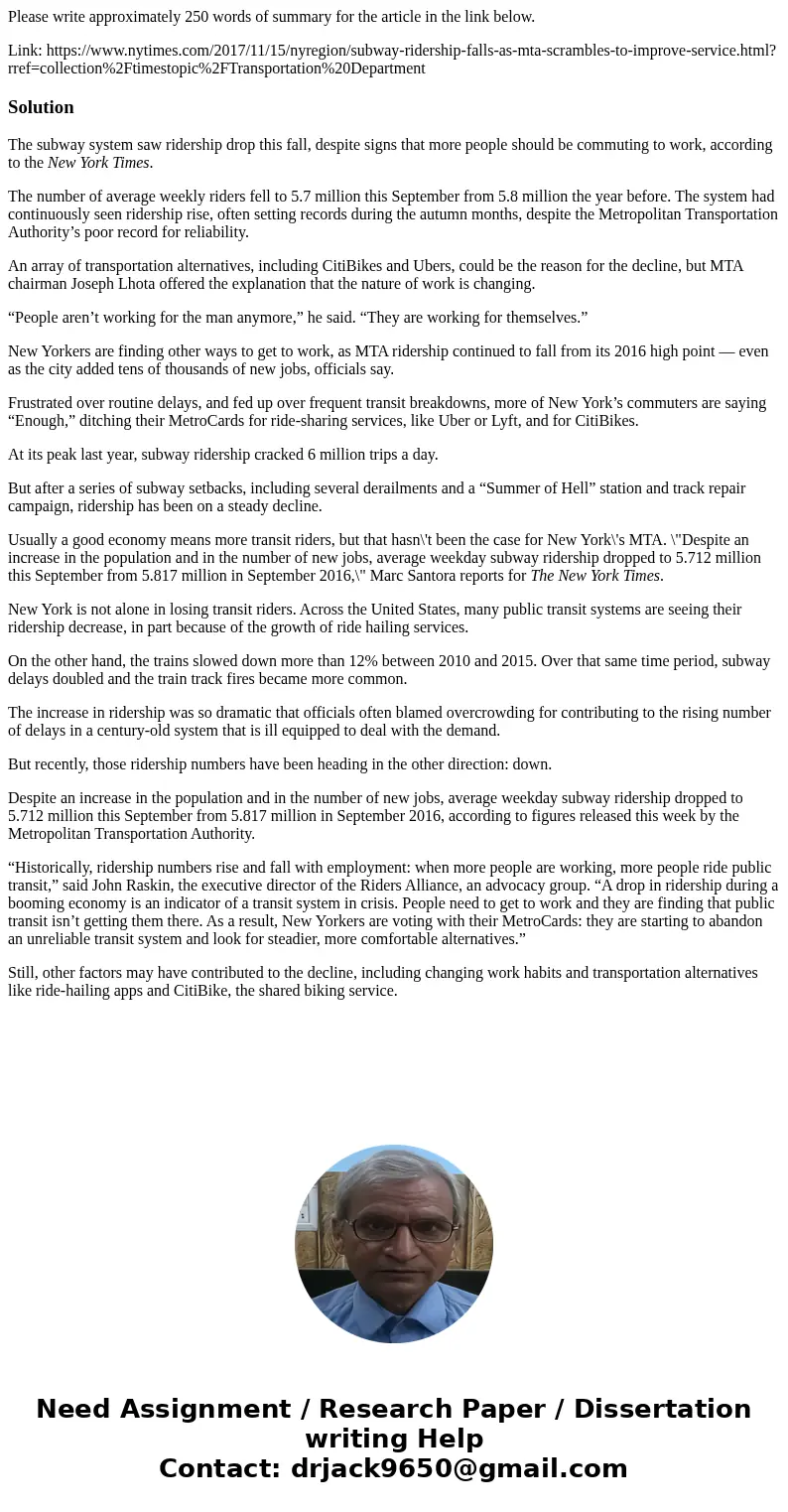Please write approximately 250 words of summary for the arti
Please write approximately 250 words of summary for the article in the link below.
Link: https://www.nytimes.com/2017/11/15/nyregion/subway-ridership-falls-as-mta-scrambles-to-improve-service.html?rref=collection%2Ftimestopic%2FTransportation%20Department
Solution
The subway system saw ridership drop this fall, despite signs that more people should be commuting to work, according to the New York Times.
The number of average weekly riders fell to 5.7 million this September from 5.8 million the year before. The system had continuously seen ridership rise, often setting records during the autumn months, despite the Metropolitan Transportation Authority’s poor record for reliability.
An array of transportation alternatives, including CitiBikes and Ubers, could be the reason for the decline, but MTA chairman Joseph Lhota offered the explanation that the nature of work is changing.
“People aren’t working for the man anymore,” he said. “They are working for themselves.”
New Yorkers are finding other ways to get to work, as MTA ridership continued to fall from its 2016 high point — even as the city added tens of thousands of new jobs, officials say.
Frustrated over routine delays, and fed up over frequent transit breakdowns, more of New York’s commuters are saying “Enough,” ditching their MetroCards for ride-sharing services, like Uber or Lyft, and for CitiBikes.
At its peak last year, subway ridership cracked 6 million trips a day.
But after a series of subway setbacks, including several derailments and a “Summer of Hell” station and track repair campaign, ridership has been on a steady decline.
Usually a good economy means more transit riders, but that hasn\'t been the case for New York\'s MTA. \"Despite an increase in the population and in the number of new jobs, average weekday subway ridership dropped to 5.712 million this September from 5.817 million in September 2016,\" Marc Santora reports for The New York Times.
New York is not alone in losing transit riders. Across the United States, many public transit systems are seeing their ridership decrease, in part because of the growth of ride hailing services.
On the other hand, the trains slowed down more than 12% between 2010 and 2015. Over that same time period, subway delays doubled and the train track fires became more common.
The increase in ridership was so dramatic that officials often blamed overcrowding for contributing to the rising number of delays in a century-old system that is ill equipped to deal with the demand.
But recently, those ridership numbers have been heading in the other direction: down.
Despite an increase in the population and in the number of new jobs, average weekday subway ridership dropped to 5.712 million this September from 5.817 million in September 2016, according to figures released this week by the Metropolitan Transportation Authority.
“Historically, ridership numbers rise and fall with employment: when more people are working, more people ride public transit,” said John Raskin, the executive director of the Riders Alliance, an advocacy group. “A drop in ridership during a booming economy is an indicator of a transit system in crisis. People need to get to work and they are finding that public transit isn’t getting them there. As a result, New Yorkers are voting with their MetroCards: they are starting to abandon an unreliable transit system and look for steadier, more comfortable alternatives.”
Still, other factors may have contributed to the decline, including changing work habits and transportation alternatives like ride-hailing apps and CitiBike, the shared biking service.

 Homework Sourse
Homework Sourse